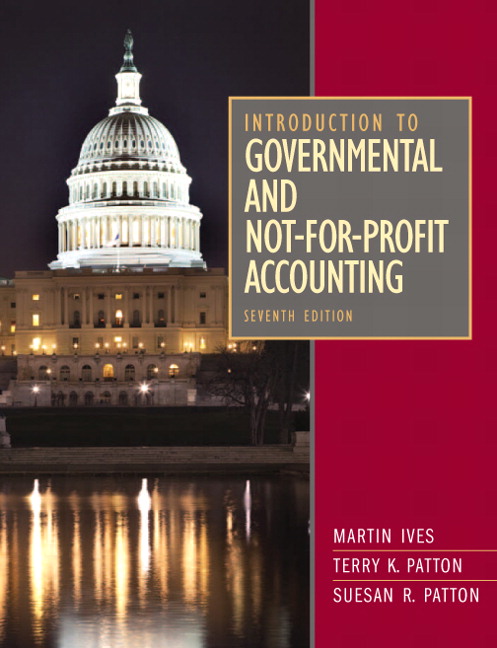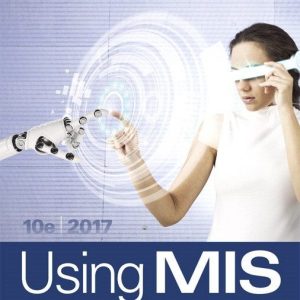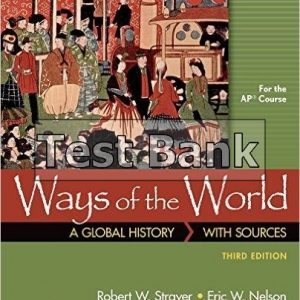Instant download Test Bank for Introduction to Governmental and Not for Profit Accounting 7th Edition by Ives pdf docx epub after payment.

Product details:
- ISBN-10 : 1118983270
- ISBN-13 : 978-1118983270
- Author: Michael H. Granof
Covering the essentials of fund accounting, this flexible book introduces the reader to the basic accounting principles at work in both governmental and not-for-profit organizations.
Table of contents:
1 The Government and Not- for- Profit Environment 1
How Do Governments and Not- For- Profits Compare With Businesses? 2
In Practice: Why Is State And Local Government Accounting Important? 6
What Other Characteristics of Governments and Not- For- Profits Have Accounting Implications? 9
How Do Governments Compare With Not-For- Profits? 12
What Are The Overall Purposes of Financial Reporting? 14
Who are The Users, and What are The Uses of Financial Reports? 14
What are The Specific Objectives of Financial Reporting As Set Forth By The GASB and The FASB? 17
Example: Clash Among Reporting Objectives 19
Do Differences In Accounting Principles Really Matter? 22
In Practice: Will Accounting Changes Make A Difference? 24
Who Establishes Generally Accepted Accounting Principles? 24
In Practice: Assessing the Profitability of An Athletic Program 25
In Practice: Governments and Not- For- Profits May Also Be Aggressive In Their Accounting 26
Summary 29
Key Terms In This Chapter 30
Questions For Review and Discussion 30
Exercises 31
Continuing Problem 33
Problems 33
Questions For Research, Analysis, And Discussion 37
2 Fund Accounting 38
What is a Fund? 39
What are the Key Elements of Government Financial Statements? 39
What Characterizes Funds? 41
Use of Multiple Funds to Account for An Entity 44
Basis of Accounting and Measurement Focus 45
Example: Fund Accounting in a School District 46
Major VS. Nonmajor Funds 49
How Can Funds be Combined and Consolidated? 49
What are the Main Types of a Government’s Funds? 59
What’s Notable About Each Type of Governmental Fund? 61
What’s Notable About Each Type of Proprietary Fund? 64
What’s Notable About Each Type of Fiduciary Fund? 70
What is Included in a Government’s Annual Comprehensive Financial Report (ACFR)? 71
Example: Government-Wide Statement of Activities 74
How Do the Funds and Annual Reports of Not-For-Profits Differ From Those of Governments? 75
Summary 78
Key Terms In This Chapter 80
Exercise for Review and Self-Study 80
Questions for Review and Discussion 81
Exercises 82
Continuing Problem 85
Problems 86
Questions for Research, Analysis, and Discussion 91
Solution to Exercise for Review and Self-Study 92
3 Issues of Budgeting and Control 95
What are the Key Purposes of Budgets? 96
Why is More Than One Type of Budget Necessary? 96
How are Expenditures and Revenues Classified? 98
Why are Performance Budgets Necessary? 99
What are the Key Phases of the Budget Cycle? 101
In Practice: Budgeting In The Midst of a Pandemic 103
On What Basis of Accounting are Budgets Prepared? 105
In Practice: States Balance Their Budgets the Painless Way 106
In Practice: The Cost of GAAP 107
In Practice: Balancing the Budget by Selling Assets to Yourself 108
What Cautions Must be Taken in Budget-to-Actual Comparisons? 108
How Does Budgeting in Not-For-Profit Organizations Compare with that in Governments? 111
How Do Budgets Enhance Control? 112
What are the Distinctive Ways Governments Record Their Budgets? 114
Example: Budgetary Entries 115
An Alternative Method: Crediting or Debiting the Difference Between Revenues and Expenditures to “Budgetary Control” 117
How Does Encumbrance Accounting Prevent Overspending? 117
Example: The Encumbrance Cycle—Year 1 118
Example: The Encumbrance Cycle—Year 2 120
Example: Impact of Encumbrances on Fund Balance 121
Are Budgetary and Encumbrance Entries Really Needed? 124
Summary 125
Key Terms in this Chapter 125
Exercise for Review and Self-Study 126
Questions for Review and Discussion 126
Exercises 127
Continuing Problem 131
Problems 131
Questions for Research, Analysis, and Discussion 139
Solution to Exercise for Review and Self-Study 139
4 Recognizing Revenues in Governmental Funds 141
Why and How Do Governments Use the Modified Accrual Basis? 141
What are the Main Types of Nonexchange Revenues and the Limitations on How and When They Can be Used? 145
How Should Property Taxes and Other Imposed Nonexchange Revenues be Accounted for? 146
I n Practice: In Practice: Just as it did with individuals, corona viruses make some governments
far more sick than others 146
Example: Property Taxes 148
Example: Fines 153
How Should Sales Taxes and Other Derived Tax Revenues be Accounted for? 154
Example: Sales Taxes 154
Example: Sales Taxes Collected by State 156
Example: Income Taxes 157
What are Tax Abatements and Why and How Must They be Disclosed? 159
How Should Grants and Similar Government-Mandated and Voluntary Nonexchange Revenues be Accounted For? 160
Example: Unrestricted Grant with Time Requirement 161
Example: Grant with Purpose Restriction 162
Example: Reimbursement (Eligibility Requirement) Grant 162
Example: Unrestricted Grant with Contingency Eligibility Requirement 163
Example: Endowment Gift 163
Example: Pledges 163
Example: Donations of Land for Differing Purposes 164
Example: On-Behalf Payments 167
How Should Sales of Capital Assets be Accounted For? 167
Example: Sales of Capital Assets 168
How Should Licenses, Permits, and Other Exchange Transactions be Accounted for? 169
Example: License Fees 169
How Should Governments Report Revenues in their Government-Wide Statements? 170
Summary 171
Key Terms In This Chapter 173
Exercise for Review and Self-Study 173
Questions for Review and Discussion 174
Exercises 174
Continuing Problem 178
Problems 178
Questions for Research, Analysis, and Discussion 184
Solution to Exercise for Review and Self-Study 185
5 Recognizing Expenditures in Governmental Funds 187
Hierarchical Approach to Transaction Analysis 187
How is the Accrual Concept Modified for Expenditures? 189
How Should Wages and Salaries be Accounted for? 190
Example: Wages and Salaries 190
How Should Compensated Absences Be Accounted For? 191
In Practice: Changing the Pay Date by One Day 191
Example: Vacation Leave 192
Example: Sick Leave 193
Example: Sabbatical Leave 196
How Should Pensions and Other Postemployment Benefits Be Accounted For? 197
Example: Pension Expenditure 197
How Should Claims and Judgments Be Accounted For? 198
Example: Claims and Judgments 198
How Should the Acquisition and Use of Materials and Supplies Be Accounted For? 200
Example: Supplies 200
How Should Prepayments Be Accounted For? 203
Example: Prepayments 203
How Should Capital Assets Be Accounted For? 205
Example: Capital Assets 205
Example: Installment Notes 206
Example: Capital Leases 207
How Should Interest and Principal on Long-Term Debt Be Accounted For? 208
Example: Long-term Debt 209
In Practice: California School Children May Pay for Their Own Education 210
How Should Nonexchange Expenditures be Accounted for? 212
Example: Unrestricted Grant with Time Requirement 212
Example: Grant with Purpose Restriction 213
Example: Reimbursement (Eligibility Requirement) Grant 213
How Should Interfund Transactions Be Accounted For? 214
Example: Interfund Transfer 215
Example: Interfund Purchase/Sale 215
How Should Revenues, Expenditures, and Other Financing Sources and Uses Be Reported? 218
In Practice: Is the Coronavirus Pandemic an Extraordinary or Special Event? 218
What is the Significance of the Current Financial Governmental Fund Statements? An Overview 219
Summary 220
Key Terms In This Chapter 221
Exercise for Review and Self-Study 221
Questions for Review and Discussion 222
Exercises 223
Continuing Problem 227
Problems 227
Questions for Research, Analysis, and Discussion 233
Solution to Exercise for Review and Self-Study 233
People also search:
Introduction to Governmental and Not for Profit Accounting 7th Edition
Introduction to Governmental and Not for Profit Accounting
Introduction to Governmental and Not for Profit Accounting 7th Edition pdf
what are governmental and not for profit organization
governmental not-for-profit organizations examples





